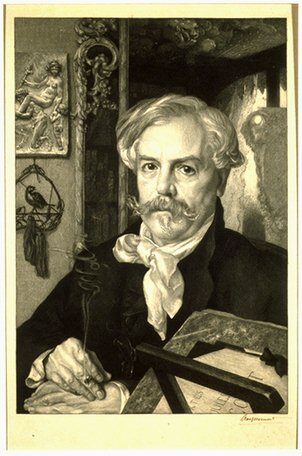Portrait of Edmond de Goncourt
Félix Bracquemond

Description
A key figure in the 19th-century etching revival, Félix Bracquemond made more than 900 prints, of which nearly 100 are portraits of luminaries of his day. The Museum's impression of Edmond de Goncourt is one of these. Wedding technical mastery to psychological acumen, Bracquemond aptly revealed his sitter's interests and character.
Edmond de Goncourt (1822-1896) and his younger brother Jules are renowned for their collaborative writing. Their proto-Naturalist novels examined the social classes and their art criticism focused on the 18th century. Their mammoth Journal was both memoir and social and literary history. Edmond founded the Académie Goncourt, which continues to award the prestigious Prix Goncourt, a yearly prize for French literature. Bracquemond's friendship with the brothers began in 1856, the year he discovered Japanese art. Thirty years later he introduced the work of Rodin to Edmond, who had outlived Jules.
The portrait shows Edmond in half-length, seated in his study. Objects reveal his fascination with Rococo and Japanese art: an unglazed porcelain vase from Vincennes reflected in the ornate mirror, a bas-relief by the 18th-century French sculptor Clodion, and below that a bronze Japanese sculpture with a crow. Lying before the sitter is a portfolio of etchings by Jules, which evokes his deceased brother and suggests Edmond's devotion to his memory. His own gaze meets the viewer's confidently.
Bracquemond's minute description of surfaces parallels the accumulation of detail in a Goncourt novel. This portrait was drawn from life, and in working his plate the artist relied on a highly finished drawing. Beginning with outlines, hatching, and tiny dots, he took the plate through a series of changes culminating in the 8th state—of which our print is an impression—that suggests a profusion of textures and reflections. The evanescent curl of cigarette smoke is a consummate touch. The print took years to do; begun by October 2, 1879, as noted in Edmond's Journal, it was only published in 1882.
Annette Dixon, Curator of Western Art
A Closer Look, 1993
Usage Rights:
If you are interested in using an image for a publication, please visit https://umma.umich.edu/request-image/ for more information and to fill out the online Image Rights and Reproductions Request Form.